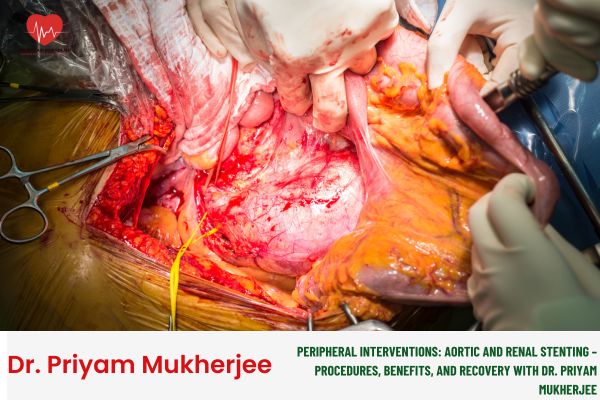Peripheral Interventions: Aortic and Renal Stenting – Procedures, Benefits, and Recovery with Dr. Priyam Mukherjee
Introduction
Peripheral artery disease (PAD) can severely impact blood circulation, increasing the risk of organ damage. Aortic and renal stenting are advanced minimally invasive treatments that help restore blood flow, preventing life-threatening conditions such as aortic aneurysms and kidney failure.
Dr. Priyam Mukherjee, a renowned vascular specialist, provides insights into these procedures, their advantages, and the recovery process to help patients make informed healthcare decisions.
What is Aortic Stenting?
Aortic stenting is a vascular intervention used to treat blockages or aneurysms in the aorta, the largest artery in the body. A stent, a small metallic mesh tube, is inserted to keep the artery open and improve circulation.
When is Aortic Stenting Needed?
- Aortic aneurysms (bulging of the aorta, which may rupture)
- Aortic stenosis (narrowing due to plaque buildup)
- Trauma or injury to the aorta
Procedure:
- Catheter Insertion: A small tube is inserted into an artery, usually through the groin.
- Balloon Angioplasty: A balloon is inflated to expand the narrowed artery.
- Stent Placement: A stent is positioned to keep the artery open.
- Final Check: Blood flow is monitored to ensure proper function.
Benefits of Aortic Stenting:
- Minimally invasive (no major incisions)
- Faster recovery compared to open surgery
- Lower risk of complications
- Effective in preventing aneurysm rupture
What is Renal Stenting?
Renal stenting is used to treat renal artery stenosis, a condition where kidney arteries narrow, leading to reduced blood supply. This can result in high blood pressure and kidney dysfunction.
When is Renal Stenting Needed?
- Renal artery stenosis (narrowed arteries supplying the kidneys)
- Uncontrolled high blood pressure
- Chronic kidney disease due to poor blood flow
Procedure:
- Accessing the Artery: A catheter is inserted through the groin or wrist.
- Balloon Inflation: A balloon is expanded to open the narrowed artery.
- Stent Placement: A mesh stent is inserted to maintain proper blood flow.
- Monitoring: The success of the procedure is confirmed using imaging techniques.
Benefits of Renal Stenting:
- Improves kidney function
- Helps control high blood pressure
- Prevents kidney failure
- Minimally invasive with a short recovery time
Recovery After Aortic and Renal Stenting
Patients typically return home within 24-48 hours after the procedure.
Post-Procedure Care:
- Medications: Blood thinners are prescribed to prevent clot formation.
- Lifestyle Changes: A healthy diet, exercise, and quitting smoking are crucial for long-term success.
- Follow-Up Appointments: Regular check-ups with Dr. Priyam Mukherjee are recommended to monitor the stent’s function.
Potential Risks:
- Mild bruising at the catheter insertion site
- Risk of blood clots (managed with medications)
- Rare chance of artery re-narrowing
Why Choose Dr. Priyam Mukherjee for Peripheral Interventions?
Dr. Priyam Mukherjee is a leading expert in vascular interventions, specializing in minimally invasive procedures like aortic and renal stenting. His expertise ensures patients receive safe, effective, and personalized treatment for their vascular conditions.
Conclusion
Aortic and renal stenting are lifesaving procedures that restore blood flow and prevent severe complications. With advanced vascular interventions, patients can enjoy improved circulation, better kidney function, and a healthier life.
If you or a loved one is experiencing vascular issues, consult Dr. Priyam Mukherjee today for expert advice and treatment.
📞 Schedule a Consultation Now!
Would you like any modifications or additional details?
